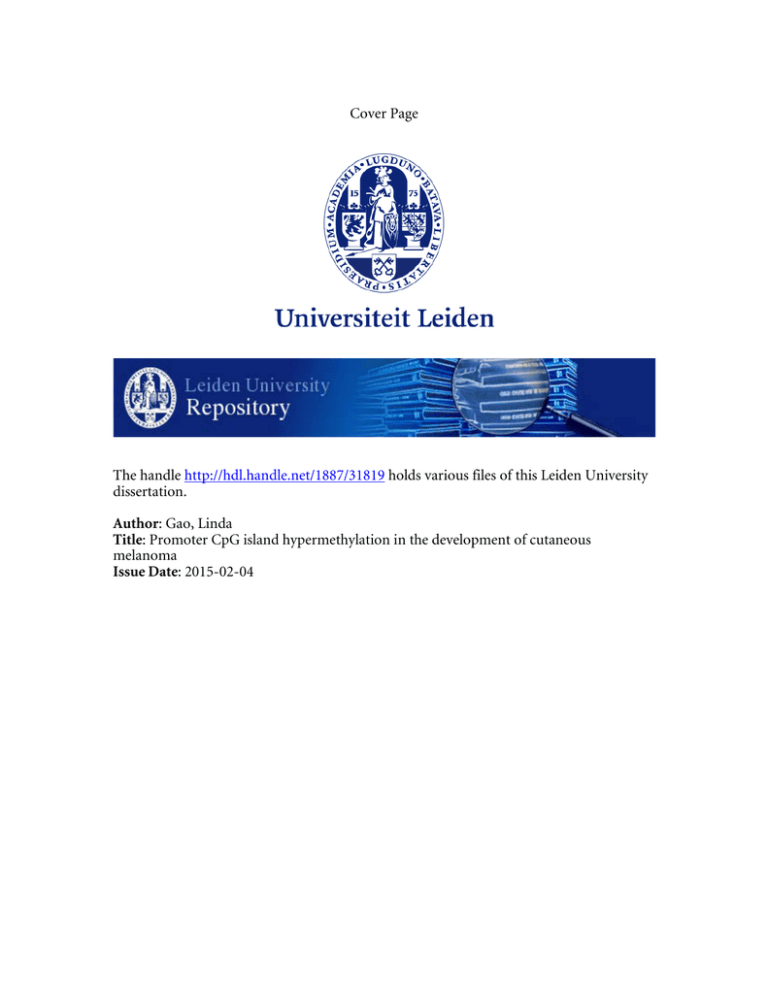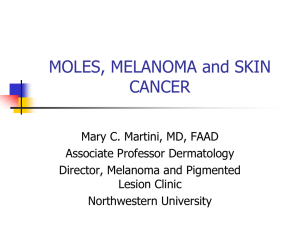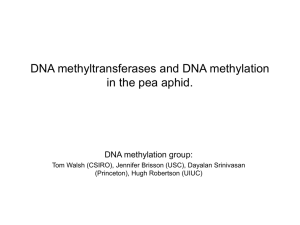Vaste Pagina`s - Voor 30 november post-p
advertisement

Cover Page The handle http://hdl.handle.net/1887/31819 holds various files of this Leiden University dissertation. Author: Gao, Linda Title: Promoter CpG island hypermethylation in the development of cutaneous melanoma Issue Date: 2015-02-04 Chapter 7 Summary and Discussion Chapter 7 The development of melanoma is driven by an accumulation of molecular aberrations in melanocytes. These aberrations can be genetic and epigenetic events as research has shown over the years. Epigenetic events such as DNA methylation alterations and histone modifications are involved in chromatin organization and regulation of gene expression. Promoter CpG island hypermethylation of tumor suppressor genes has also been found in melanoma. Until now, DNA methylation studies have focused on selected genes and were mostly limited to metastatic melanoma cell lines (described in Chapter 1). Our aim was to obtain a genome-wide view of promoter methylation in primary melanoma biopsy tissue in order to identify melanoma suppressor genes, and to identify diagnostic and prognostic biomarkers. Promoter hypermethylation in primary melanoma In this thesis, we report the first genome-wide profiling of DNA methylation alterations in primary cutaneous melanoma and common naevus biopsy specimens. Genome-wide DNA methylation profiling identified 106 genes as significantly and frequently hypermethylated in primary melanoma when compared to common naevus. Among the genes most frequently hypermethylated in melanoma were HOXA9, MAPK13, CDH11, PLEKHG6, PPP1R3C and CLDN11. Aside from HOXA9, for which methylation was found in a sizeable proportion of common naevi, promoter methylation of the other genes was almost absent in naevi but occurred frequently in melanomas (Chapter 2). Of the 106 most frequently methylated genes, 11 genes have been reported as methylated in melanoma and 32 genes as methylated in other cancer types. The PPP1R3C, CDH11 and HOXA9 gene promoters have previously been reported to be hypermethylated in melanoma cell lines and metastatic samples1-4. Methylation of the MAPK13, PLEKHG6 and CLDN11 gene promoters, occurring in up to 67% of primary melanoma cases as detected by bisulphite melting curve analysis, has not been reported in melanoma yet. From the 106 identified genes, one gene (RNF43) was listed in the Cancer Gene Census as a putative tumor suppressor gene5. The Cancer Gene Census has 54 genes (8%) that overlap with the tumor suppressor gene database (TSGene) that consists of 716 human genes up to date. From the 106 genes SERPINB5 (Maspin), CHFR and RARβ were listed in TSGene as known tumor suppressors based on multiple independent studies in literature. CDH11, GNMT, NR4A1 and MTSS1 were listed as putative tumor suppressors6. Genome-wide methylation profiling has revealed the presence of widespread and frequent DNA methylation alterations in primary melanoma. Based on further methylation analyses in sets of common naevi, dysplastic naevi, primary and metastatic melanomas, we have begun to obtain a view of the onset of methylation events that may be important in the development of melanoma (Figure 1). We have observed the presence of HOXA9, MAPK13 and CNTN1 promoter methylation in a subset of common and dysplastic naevi, 146 Summary and Discussion and in 40% - 80% of primary melanomas. Interestingly, genes such as CDH11, PPP1R3C and PLEKHG6 were progressively hypermethylated in dysplastic naevi, primary and metastatic melanomas, with almost absent methylation in common naevi (Chapter 3). This suggests a potential role of these genes in suppressing the onset of dysplastic features in melanocytic lesions. The promoter hypermethylation frequency of a selected panel of genes appeared to increase gradually from the common naevus to the dysplastic naevus stage. In primary melanoma samples however, the number of methylated genes demonstrated a sharp increase, indicating that malignant transformation is associated with epigenetic deregulation. Using this approach, we have identified CLDN11 as a potential biomarker to distinguish dysplastic naevi from primary melanoma (Chapter 3). CLDN11 encodes a member of the claudin family, components of tight junctions that maintain a physical barrier and the polarity of cells. Loss of CLDN11 expression through promoter hypermethylation during melanoma development may facilitate invasive behavior by 7 disrupting intercellular cohesion provided by tight junction structures . Genome-wide methylation profiling was performed using Illumina’s Infinium HumanMethylation27K platform that interrogates 27,578 CpG sites located within the promoter regions of a total of 14,495 genes. Recently, beadchips have become available that allow examination of methylomes with an even higher resolution; the 450K beadchip interrogates more than 480.000 cytosines distributed over the whole genome inside and outside of gene promoter regions. Whole-genome bisulphite sequencing, based on nextgeneration sequencing of bisulphite-treated DNA, has made it possible to analyze the approximately 30 million CG-dinucleotides in the human genome. These more recent techniques can aid in the identification of additional differentially methylated CpG sites that hold potential diagnostic or prognostic value, since they enable interrogating an extensive number of CpG sites at once. The additional value of methylation analyses using these high-resolution platforms, however, may be limited. One reason is that promoter CpG island methylation remains the most relevant when it comes to direct implications in gene transcription regulation. Approximately 50% of all 30.000 human gene promoters contain a CpG island, methylation of which is often associated with transcriptional repression. The 14,495 gene promoters interrogated by Illumina's 27k beadchip covers almost all of these CpG island-containing gene promoters. 147 Chapter 7 Figure 1. A melanoma progression model with the hypothesized timing of the most frequently occurring epigenetic events in the different stages of melanocytic neoplasia. MAPK13 and RASEF, candidate melanoma suppressor genes Promoter CpG island methylation is believed to contribute to the development and progression of cancer by transcriptional repression of tumor suppressor genes, providing a selective advantage to tumor cells. Established tumor suppressor genes that are often inactivated in cancer such as CDKN2A and PTEN have been found to be affected by aberrant promoter methylation in melanoma. We hypothesized that among the 106 most frequently methylated genes could be potential novel genes with a tumor suppressive role in melanoma. MAPK13, encoding p38δ, belonged to the five most frequently hypermethylated genes in primary melanoma that were identified. Due to its suggested tumor suppressive function and the potential involvement of p38 MAPK proteins in oncogene-induced senescence, we have performed additional experiments focused on MAPK13. To evaluate tumor suppressive properties, MAPK13 expression was restored in several melanoma cell lines affected by promoter hypermethylation of this gene; we observed that this resulted in a significant decrease of proliferative capacity of these cells (Chapter 2). Together with the finding of MAPK13 promoter methylation in a proportion of common naevi, our data suggests that MAPK13 silencing by methylation might be an early event that has a role in melanoma development. Similar to our findings but in a different cancer type, MAPK13 has been suggested to be involved in the suppression of oesophageal squamous cell carcinoma (OESCC) through observations of decreased cell proliferation and migration, and altered anchorage-independent growth when MAPK13 was introduced in OESCC cells that did not have endogenous MAPK13 expression, with an even greater effect when the active phosphorylated form of MAPK13 was used8. Mouse embryonic fibroblasts lacking MAPK13 were previously found to have diminished cell contact inhibition and to proliferate and migrate faster than their wildtype counterparts9. Another study observed that phosphorylation of p53 by members of the p38 and JNK family of MAP-kinases, including p38δ, upon depletion of SEPW1 mediated a transient G1 cell cycle arrest in epithelial cells10. For keratinocytes it was found that PKCδ suppressed 148 Summary and Discussion proliferation via activation of MAPK13, leading to an increase in p53 levels and increased Cip1,11 . Together these findings point to potential tumor suppressive expression of p21 properties of MAPK13 that involves stabilization and activation of p53. In the process of malignant transformation towards cancer, oncogene-induced senescence (OIS) has been identified as a mechanism to protect against the onset of cancer in response to aberrant oncogenic activity. We were not able to observe a bypass of BRAFV600E-induced senescence upon MAPK13 depletion. This can be due to redundancy in function of the four p38 MAPK isoforms in melanoma cells and therefore depletion of MAPK13 was not sufficient to bypass senescence. Recently it was shown that RASactivated p38 induced the pro-senescent function of Tip60 via phosphorylation of both Tip60 and PRAK, providing evidence for a signaling pathway involving p38 that mediated oncogene-induced senescence. Upon activation by oncogenic RAS only two isoforms, p38α (MAPK14) and p38δ (MAPK13), were observed to mediate phosphorylation of Tip60 at Thr158/106 in senescent cells, while all four p38 isoforms (p38α, MAPK14; p38β, MAPK11; p38γ, MAPK12; p38δ, MAPK13) phosphorylated Tip60 in vitro. These results indicate potentially overlapping functions for the p38α and p38δ isoforms in mediating senescence12. Another study however found that p38δ was able to mediate RAS-induced senescence, with enhancement of p38δ expression during senescence via induction of the RAF1-MEK-ERK pathway by oncogenic RAS13. Since these studies found p38δ involved in senescence induced by oncogenic RAS, it may be mainly involved in the response induced by this oncogene and not by mutant BRAF. Differences exist between the four p38 isoforms in terms of different cofactors that regulate phosphorylation, and different accessibility to phosphorylation targets. Insight into how the phosphorylation activity of each p38 isoform is regulated and how it affects signaling downstream, may aid in further understanding the role of the p38 kinases in mutant BRAF-induced senescence. In Chapter 2, bisulphite melting curve analysis (BMCA) was used to assess the promoter methylation status of fresh-frozen biopsy specimens. Here, no significant MAPK13 promoter methylation was observed in the investigated common naevi. In Chapter 4 MAPK13 methylation was observed in 18% of investigated formalin-fixed paraffin-embedded (FFPE) biopsy samples using methylation-specific PCR (MSP). The MSP as applied in Chapter 4 is able to detect one methylated allele in a background of at least 1000 unmethylated alleles14. Therefore MSP has been more sensitive than BMCA in detecting methylation even in a tiny fraction of cells. At least 5% of methylated DNA was required in order for BMCA to detect methylation. MAPK13 methylation assessment using BMCA and MSP on a set of naevi and melanomas showed 84% concordance (described in Chapter 4). Cases that did not have concordant results between the BMCA and MSP techniques were all specimens that were considered as ‘unmethylated’ using BMCA, and as ‘methylated’ when MSP was used. From our observations of methylation detection 149 Chapter 7 with BMCA and MSP, we assume that small subpopulations of melanoma cells exist that are positive for methylation of MAPK13 that are not detectable by BMCA. In order to identify novel genes required for induction of senescence following expression of mutant BRAF, a functional shRNA screen was performed targeting approximately 15.000 genes. Primary analysis yielded 40 genes and from secondary validation seven genes essential for BRAF-induced senescence emerged, including the RASEF gene. Upon reanalysis of genome-wide methylation profiles RASEF was among the genes most frequently methylated in BRAF-mutant melanoma. Subsequent analysis in a larger series of melanoma samples demonstrated that RASEF was methylated in 21% of primary melanomas. Upon validation, RASEF methylation appeared not to be restricted to tumors with BRAF mutation. (Chapter 3). Depletion of RASEF mediated a bypass of V600E -induced senescence and the suppression of senescence biomarkers including BRAF senescence-associated (SA)-β-galactosidase activity, interleukins and tumor suppressor p15INK4B. In addition, a growth-restrictive effect was observed in melanoma cells where epigenetically silenced RASEF expression was restored. These findings suggest the identification of a potential new tumor suppressor gene in melanoma (Chapter 3). RASEF promoter hypermethylation and a correlation between RASEF methylation and expression have been previously described in uveal melanoma, a melanoma subtype that differs in genetic and clinical characteristics from cutaneous melanoma15. The chromosomal region on 9q21.32 where RASEF is located has been proposed previously as a susceptibility locus in members of three Danish families with cases of cutaneous and uveal melanoma16. Together with our findings, these results indicate that RASEF inactivation may be important for both cutaneous and uveal melanoma development, suggesting a common ground that may underlie tumorigenesis of both melanoma subtypes. We propose that RASEF is a melanoma suppressor gene, inactivation of which prevents the onset of a senescence response that normally occurs upon expression of mutant BRAF. For MAPK13 and RASEF, we have made a start in Chapter 2 and Chapter 3 of this thesis to characterize their potential tumor suppressive function in melanoma. An assessment of MAPK13 and RASEF function using in vivo assays will be needed for a more 17 definitive demonstration that MAPK13 and RASEF are tumor suppressors . MAPK13 mutation was found in 2 of 319 (0.6%) melanoma tissues in the Catalogue of somatic mutations in cancer (COSMIC), and RASEF mutation was found in 3 of 314 (1.0%) of melanoma tissues. This may be an indication that inactivation of MAPK13 and RASEF function is mainly brought about by promoter methylation. Also other genes, such as the HIC1 tumor suppressor gene are known to be primarily inactivated by promoter hypermethylation rather than mutation18. 150 Summary and Discussion Promoter methylation and gene expression in dysplastic naevus The dysplastic naevus is considered an intermediate stage of melanocytic lesion between a common naevus and a primary melanoma. Clinically the distinction between dysplastic naevus and early-stage melanoma remains challenging for a proportion of cases. We set out to examine the promoter methylation status of a selection of genes that were identified using genome-wide methylation profiling, in a total of 405 melanocytic neoplasms (Chapter 4). Promoter methylation analysis in common naevi, dysplastic naevi, primary melanomas and metastatic melanomas demonstrated progressive epigenetic deregulation. We also observed that dysplastic naevi were affected by promoter methylation of genes that were frequently methylated in melanoma but not in common naevi. CLDN11 promoter methylation was the most selective for melanoma as it occurred in 50% of primary melanomas and only 3% of dysplastic naevi. Promoter methylation of CLDN11 has been previously reported in bladder and gastric cancer and was shown to be associated with transcriptional silencing19,20 Next we assessed the diagnostic value of the methylation status of five genes in distinguishing primary melanoma from dysplastic naevus. A diagnostic model that incorporated methylation of CLDN11, CDH11, PPP1R3C, MAPK13 and GNMT was validated in an independent sample series and helped distinguish melanoma from dysplastic naevus (AUC 0.81). We did not find a single gene methylation event that could completely distinguish melanoma from naevus samples in all cases. However the combined detection of CLDN11, CDH11 and PPP1R3C promoter methylation yielded a specificity of 89% and sensitivity of 67%. In addition to DNA methylation, we have also examined differences in gene expression of the melanocytes derived from dysplastic naevus and melanocytes from adjacent normal skin. To gain insight into the molecular pathways that may underlie the elevated oxidative stress levels in dysplastic naevus melanocytes, we compared the gene and protein expression patterns of cultured melanocytes derived from dysplastic naevus and melanocytes from adjacent normal skin. Our findings indicate that gene expression patterns from cultured melanocytes derived from dysplastic naevi are largely similar to those of melanocytes derived from normal skin. The main differences were observed with genes involved in cellular metabolism, detoxification and cytoskeletal organization. Melanocytes derived from dysplastic naevi also differed in morphology and proliferation rate from the melanocytes derived from adjacent normal skin (Chapter 5). However overall, the differences between the two melanocyte types were small. The initially existent expression differences may have been subtle due to artefacts introduced by short culturing of the melanocytes; it is possible that we were subsequently not able to detect significant differential mRNA levels between the melanocytes derived from dysplastic naevi and melanocytes derived from adjacent normal skin. Previous mRNA and protein expression studies that analyzed normal naevi, dysplastic naevi, primary and metastatic 151 Chapter 7 melanomas observed that expression differences between normal melanocytes and 21-24 . Our findings in Chapter 5 are in melanocytes from dysplastic naevi are relatively small line with these observations. Dysplastic naevi were also previously found to display significant heterogeneity in their gene expression profiles, where some dysplastic naevi resembled their normal counterparts while other dysplastic naevi more closely resembled primary melanomas when comparing gene expression patterns. The existence of this heterogeneity can make it more difficult to correctly identify differential gene expression patterns in our microarray analysis and requires approaches that can more accurately determine differential expression in a more defined, small number of dysplastic naevus cells. Taken together the observations made in Chapter 4 and 5 show that dysplastic naevi, also those with severe atypia, resemble common naevi more than primary melanoma on the epigenetic and gene expression level. We found no overlap upon comparison of the differentially methylated genes between common naevi and dysplastic naevi as observed in Chapter 4, with the differentially expressed genes and proteins found in Chapter 5. In Chapter 4, the identified genes were obtained by initially comparing common naevi with primary melanomas. The most frequently methylated genes from that comparison were subsequently analyzed in common naevi and dysplastic naevi. These genes were HOXA9, C1orf106, MAPK13, CDH11, EFCAB1, CNTN1, GNMT, PLEKHG6, PPP1R3C and CLDN11 (Table 1). Out of these ten genes HOXA9, MAPK13, CNTN1, PLEKHG6 and PPP1R3C were also observed to be hypermethylated in dysplastic naevi (Table 1). The possibility remains that if the initial promoter methylation profiling was performed using common naevi and dysplastic naevi as the initial comparison, genes different than those listed in Table 1 would have been identified. In addition the comparison in Chapter 5 was performed between melanocytes from dysplastic naevi and melanocytes derived from normal skin. Altogether this can explain why no overlap was found between the identified gene candidates in Chapter 4 and 5. Prognostic biomarkers for primary melanoma with metastatic capacity The acquisition of metastatic capacity is a crucial step in melanoma progression as metastatic melanoma is often fatal whereas a localized tumor can be cured by excision. It remains a challenge to correctly predict those patients that are at high risk for metastatic disease and to determine the prognosis for patients diagnosed with melanoma, in spite of the availability of several clinical prognostic factors such as tumor thickness. Current understanding about the role of epigenetic alterations that underlie the capacity of melanoma cells to invade deeper skin regions and disseminate from the primary tumor is limited. In order to identify genes that were differentially methylated between primary melanoma with and without metastatic capacity, a re-analysis of genome-wide methyla152 Summary and Discussion Table 1. Hypermethylated genes in dysplastic naevi and primary melanomas. Genes observed as hypermethylated in either dysplastic naevus compared to common naevus (left column) or primary melanoma compared to common naevus (right column). Genes were considered hypermethylated in dysplastic naevi when more than 5% of the number of analyzed dysplastic naevi showed methylation compared to the number of common naevi (see also Figure 1, Chapter 4). common naevus vs. dysplastic naevus (Chapter 4) HOXA9 X MAPK13 X X CNTN1 X PLEKHG6 PPP1R3C X common naevus vs. melanoma (Chapter 2) HOXA9 C1orf106 MAPK13 CDH11 EFCAB1 CNTN1 GNMT PLEKHG6 PPP1R3C CLDN11 -tion data followed by validation in an independent set of primary melanomas was performed (Chapter 6). This showed that MCHR1 was significantly hypermethylated in primary melanomas with metastatic capacity. SYNPO2 was the second gene that showed substantial, but not significant, hypermethylation. Kaplan-Meier survival analysis was performed using methylation data from the TCGA database containing HumanMethylation450K Beadchip methylation data of 48 primary melanoma and 229 metastasized melanoma biopsy specimens. Due to the limited amount of patient information on metastatic capacity of the primary melanomas, the number of primary melanomas with known metastatic capacity was too small to analyze the value of potential prognostic factors. Instead, Kaplan-Meier survival analysis was carried out on the 229 metastasized melanomas from the TCGA database. This showed that a cg-probe βvalue higher than 0.50 for MCHR1 was significantly associated with a poorer survival rate (Chapter 6). It is interesting that in addition to a significant association with metastatic behavior observed in a set of primary melanomas, MCHR1 methylation is also correlated to survival outcome of metastasized melanomas. Further comparative analysis of genomewide methylation data between melanoma metastasis and primary melanoma biopsy specimens also showed significant hypomethylation of MAGEA3 and MAGEA6 in the melanoma metastasis samples. Not surprisingly, the methylation differences that we observed in the comparative analysis of primary melanomas with and without metastatic behavior were relatively small. It is likely that methylation differences, if present will be smaller than when distinct stages of melanoma progression are compared (for example naevus to melanoma). The observation of MCHR1 methylation in benign melanocytic tissue indicates that the differences in MCHR1 methylation as detected in this study are based on 153 Chapter 7 differences in methylation density of the CpG promoter region, rather than a complete presence or absence of methylation. Since the comparative analysis was performed on a small group of primary melanomas with known metastatic capacity, it is possible that upon comparison between larger sample series, more genes will be identified with significant differential methylation. Our findings in Chapter 6 suggest that the methylation status of MCHR1 and perhaps also SYNPO2 may be useful in predicting the metastatic behavior of a primary melanoma. However we have only started with a first methylation analysis. Because of the small sample sets, some methylation events may be random occurrences within the specific tumor samples used. Additional validation involving large sample sets of primary melanoma biopsies with known clinical information on metastatic capacity is necessary to determine the prognostic value of MCHR1 and SYNPO2. Especially the question whether these genes have prognostic value independent of existing clinical parameters used to predict prognosis such as Breslow’s thickness, ulceration, mitotic index, gender and age will be important. We have identified MCHR1 as a novel gene that is differentially methylated between primary melanoma with and without metastatic behavior. MCHR1 promoter methylation has not yet been previously described in cancer. MCHR1 was found to be an auto-antigen, normally expressed by human melanocytes and is thought to serve as a 25 target for auto-immune responses in certain cases . Additional analyses will be needed to establish the effect of promoter CpG island methylation density on MCHR1 expression. In line with our findings for SYNPO2, a commonly deleted region in prostate cancer was mapped to the encoding sequence of SYNPO2 (also known as Myopodin) on chromosome 4q25. Complete or partial deletion correlated with prostate cancer invasiveness and was found in 80% of the investigated invasive prostate cancer cases. SYNPO2 hypermethylation has also been observed in colon cancer cells and colorectal tissue where it was found to correlate with overall survival in two independent validation series26,27. From the candidates in our diagnostic marker panel in Chapter 4, genes such as CLDN11 and CDH11 can also be considered for testing their value as prognostic biomarkers since these genes are frequently methylated in melanoma, in which they are more frequently methylated in metastatic melanoma than in primary melanoma lesions, and they have been implicated in the processes of invasion and metastasis. Future perspectives Cancer cell genomes generally exhibit a global loss of methylation (hypomethylation) together with an aberrant increase in methylation (hypermethylation) at CpG islands, GCrich regions present in approximately half of all human gene promoters. Using promoter CpG island methylation profiling we have generated a comprehensive view of promoter 154 Summary and Discussion hypermethylation in primary melanoma and have found that aberrant methylation is widespread in melanoma when compared to common naevi. Questions still remain on what causes the widespread promoter hypermethylation in melanoma. This relates to the question on how in normal cells, CpG islands remain protected from DNA methylation. A challenge remains to further elucidate what causes epigenetic deregulation in cutaneous melanoma. Recently, ten-eleven translocation (TET) family of enzymes that oxidize 5methylcytosine to 5’-hydroxymethylcytosine were discovered and led to the insight that DNA hydroxymethylation is important in the process of dynamic cytosine modification, where 5’-methylcytosines can undergo active demethylation and are reversed back to 28,29 cytosine . This implicates a more complex regulation of gene expression than initially thought in both normal and cancer cells. The genetic lesions underlying cutaneous melanoma are becoming increasingly well understood. However an overview of the epigenetic alterations that underlie melanoma and the combined interaction between genetics and epigenetics to induce gene expression changes in the development of cutaneous melanoma is still lacking. Full insight into these molecular events and their interactions will certainly emerge in the near future. It seems that integrating data generated by new genomic and epigenomic profiling techniques is necessary to achieve this. The delineation of not only the pattern of DNA methylation, but also the pattern of histone modifications and chromatin remodeling will provide insight into the contribution of each of these epigenetic mechanisms to melanoma initiation and progression. An understanding of these underlying molecular events will aid in the search for new diagnostic and prognostic biomarkers and improve treatment of this disease. 155 Chapter 7 References 1. 2. 3. 4. 5. 6. 7. 8. 9. 10. 11. 12. 13. 14. 15. 16. 17. 18. 19. 20. 21. 22. 23. 24. 25. 26. 27. 156 Bonazzi, V.F. et al. Cross-platform array screening identifies COL1A2, THBS1, TNFRSF10D and UCHL1 as genes frequently silenced by methylation in melanoma. PLoS. One. 6(10), e26121 (2011). Carmona, F.J. et al. Epigenetic disruption of cadherin-11 in human cancer metastasis. J. Pathol. 228(2), 230240 (2012). Furuta, J. et al. Promoter methylation profiling of 30 genes in human malignant melanoma. Cancer Sci. 95(12), 962-968 (2004). Rauch, T.A. et al. High-resolution mapping of DNA hypermethylation and hypomethylation in lung cancer. Proc. Natl. Acad. Sci. U. S. A. 105(1), 252-257 (2008). Futreal, P.A. et al. A census of human cancer genes. Nat. Rev. Cancer 4(3), 177-183 (2004). Zhao, M., Sun, J., and Zhao, Z. TSGene: a web resource for tumor suppressor genes. Nucleic Acids Res. 41(Database issue), D970-D976 (2013). Martin, T.A. and Jiang, W.G. Loss of tight junction barrier function and its role in cancer metastasis. Biochim. Biophys. Acta 1788(4), 872-891 (2009). O'Callaghan, C. et al. Loss of p38delta mitogen-activated protein kinase expression promotes oesophageal squamous cell carcinoma proliferation, migration and anchorage-independent growth. Int. J. Oncol. 43(2), 405-415 (2013). Cerezo-Guisado, M.I. et al. Evidence of p38-gamma and p38-delta involvement in cell transformation processes. 32(7), 1093-1099 (2011). Hawkes, W.C. and Alkan, Z. Delayed Cell Cycle Progression in Selenoprotein W Depleted Cells Is Regulated By a Mitogen-Activated Protein Kinase Kinase 4 (MKK4)-p38/c-Jun NH2-Terminal Kinase (JNK)-p53 Pathway. J. Biol. Chem. 287(33), 27371-27379 (2012). Saha, K. et al. p38delta regulates p53 to control p21Cip1 expression in human epidermal keratinocytes. J. Biol. Chem. 289(16), 11443-11453 (2014). Zheng, H. et al. A posttranslational modification cascade involving p38, Tip60, and PRAK mediates oncogene-induced senescence. Mol. Cell 50(5), 699-710 (2013). Kwong, J. et al. Induction of p38delta expression plays an essential role in oncogenic ras-induced senescence. Mol. Cell Biol. 33(19), 3780-3794 (2013). Derks, S. et al. Methylation-specific PCR unraveled. Cell Oncol. 26(5-6), 291-299 (2004). Maat, W. et al. Epigenetic regulation identifies RASEF as a tumor-suppressor gene in uveal melanoma. Invest Ophthalmol. Vis. Sci. 49(4), 1291-1298 (2008). Jonsson, G. et al. Mapping of a novel ocular and cutaneous malignant melanoma susceptibility locus to chromosome 9q21.32. J. Natl. Cancer Inst. 97(18), 1377-1382 (2005). Vredeveld, L.C. et al. Abrogation of BRAFV600E-induced senescence by PI3K pathway activation contributes to melanomagenesis. Genes Dev. 26(10), 1055-1069 (2012). Chen, W.Y. et al. Heterozygous disruption of Hic1 predisposes mice to a gender-dependent spectrum of malignant tumors. Nat. Genet. 33(2), 197-202 (2003). Agarwal, R. et al. Silencing of claudin-11 is associated with increased invasiveness of gastric cancer cells. PLoS One. 4(11), e8002 (2009). Awsare, N.S. et al. Claudin-11 decreases the invasiveness of bladder cancer cells. Oncol. Rep. 25(6), 15031509 (2011). Alekseenko, A. et al. Cyclin D1 and D3 expression in melanocytic skin lesions. Arch. Dermatol. Res. 302(7), 545-550 (2010). Boyd, A.S., Shakhtour, B., and Shyr, Y. Minichromosome maintenance protein expression in benign nevi, dysplastic nevi, melanoma, and cutaneous melanoma metastases. J. Am. Acad. Dermatol. 58(5), 750-754 (2008). Campoli, M. et al. HLA antigen expression in melanocytic lesions: Is acquisition of HLA antigen expression a biomarker of atypical (dysplastic) melanocytes? J. Am. Acad. Dermatol. 66(6), 911-916 (2012). Scatolini, M. et al. Altered molecular pathways in melanocytic lesions. Int. J. Cancer 126(8), 1869-1881 (2010). Kemp, E.H. et al. The melanin-concentrating hormone receptor 1, a novel target of autoantibody responses in vitiligo. J. Clin. Invest 109(7), 923-930 (2002). Esteban, S. et al. Diagnostic and prognostic utility of methylation and protein expression patterns of myopodin in colon cancer. Tumour. Biol. 33(2), 337-346 (2012). Lin, F. et al. Myopodin, a synaptopodin homologue, is frequently deleted in invasive prostate cancers. Am. J. Pathol. 159(5), 1603-1612 (2001). Summary and Discussion 28. Kohli, R.M. and Zhang, Y. TET enzymes, TDG and the dynamics of DNA demethylation. Nature 502(7472), 472-479 (2013). 29. Tahiliani, M. et al. Conversion of 5-methylcytosine to 5-hydroxymethylcytosine in mammalian DNA by MLL partner TET1. Science 324(5929), 930-935 (2009). 157 Chapter 7 158









